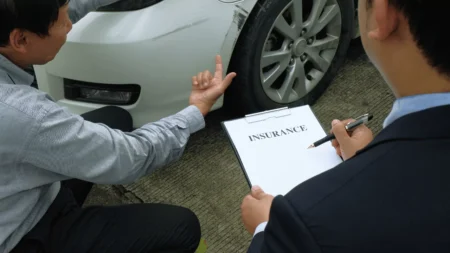Worried about hydroplaning and its effects on your car? You’re not alone! Learn all you need to know about hydroplaning and if it is covered by your insurance policy. Protect yourself from any unexpected costs today!
Hydroplaning is a form of vehicle skidding that occurs when tires on wet or flooded roads lose their ability to grip the surface and become temporarily suspended on the thin film of water between the car and the road. This can cause drivers to lose control of their vehicles, often resulting in dangerous accidents. For this reason, it is important for motorists to know whether hydroplaning is covered by insurance.
The answer depends largely on the type of insurance coverage you have purchased. Most standard auto policies provide coverage for circumstances such as hydroplaning as long as your vehicle was not traveling in excess of the speed limit at the time, however, this protection typically doesn’t extend to any damage your car might experience from being in a hydroplaned state, such as wear and tear from the skidding tires or mechanical damage incurred from sliding off the road.
Additionally, certain types of comprehensive policies may offer additional coverage for a variety of reasons depending upon your specific agreement with your insurance provider. If you are uncertain about what type of protection you currently have or if it covers incidents related to hydroplaning, it is best to contact your insurer directly so there are no surprises should an accident occur while driving through wet or flooded conditions.
What is Hydroplaning?
Hydroplaning is a common driving hazard that occurs when a vehicle’s tires lose contact with the road surface due to excessive water present on the roadway. This happens when water accumulates faster than a tire can dissipate it, resulting in “floating” on the surface. When this occurs, the vehicle will skid and not respond to steering or brake input—causing it to drift across lanes or potentially lose control while cornering.
Drivers often face dangerous hydroplaning conditions in wet weather, where braking distances are extended and visibility could be reduced by vision obscured with water droplets or fog. Additionally, hydroplaning can occur even at moderate speeds as low as 35 miles per hour (mph), making it important for drivers to remain alert while driving on wet surfaces.
The potential hazard of hydroplaning is why insurance companies typically do not cover damage caused by it—since hydroplaning is considered to be a preventable accident caused by the driver’s own inexperience or negligence. Therefore, if you find yourself facing slippery roads and experiencing any signs of skidding, exercise caution and reduce your speed accordingly to avoid any potential risks associated with hydroplaning.
Insurance Coverage for Hydroplaning
Hydroplaning is an often-unexpected event in which a vehicle will temporarily skid across a layer of water, leaving the driver with little control over their vehicle. In the event of a hydroplaning accident, it’s important to understand what type of insurance covers this type of incident.
The majority of insurance companies will provide coverage for hydroplaning as long as the policyholder carries the necessary coverage and has met all other requirements specified in the policy. However, some policies may include exclusions or limitations to coverage that should be taken into consideration when preparing a claim.
- Most companies will only cover costs associated with property damage if there was an additional cause contributed to dangerous driving conditions from the policyholder such as exceeding speed limits or decelerating unexpectedly.
- Coverage usually does not extend to any death or bodily injury caused by hydroplaning.
It’s also important to understand that insurance companies typically place limits on coverage for Hydroplaning-related incidents, so it’s essential to know what your policy limits are before filing a claim with your insurance company after suffering from an accident due to hydroplaning events on your vehicle! Furthermore, many companies have deductibles associated with these claims that need to be accounted for when deciding whether or not filing a claim is worth it in the long run.
In conclusion, while insurance typically covers incidents related to Hydroplaning, there are still many exclusions and limitations to keep in mind when filing a claim so be sure you understand each component of your individual policy before moving forward with an accident-related claim due to hydroplaning events on your vehicle!
How to Prevent Hydroplaning?
Hydroplaning occurs when water accumulates faster than a vehicle’s tires can disperse it, resulting in a loss of traction and steering control. While hydroplaning can be unpredictable and dangerous, there are steps drivers can take to reduce the risk.
- Ensure your tires have the proper tread depth recommended by your vehicle manufacturer. Deep grooves help channel the water away from the tires while shallow tread causes more standing water to be picked up than the tire can disperse. Fortunately, you don’t need to purchase new tire sets often as some types of tread patterns offer greater depth over time with use.
- Reducing speed is also key when traveling through wet or slippery conditions like rain or slush. The higher a vehicle’s speed, the less effective the tread is at dispelling water. Additionally, reducing speed will give drivers more time to react if they begin to hydroplane in order to regain control safely.
- Along with these two methods, inflate your tires according to the manufacturer’s instructions and replace them every 6 years regardless of wear since rubber becomes brittle over time and may lead to hydroplaning as well.
- Finally be aware of areas that tend to cause water build-ups like puddles, potholes, or manholes that won’t benefit from generally draining roads during rain – namely gutters along curbs – so it is best avoided where possible during wet weather.
Taking these steps helps drivers prevent hydroplaning and increase safety on roadways for everyone involved which should be a priority for all motorists.
What does it Feel Like when Your Car is Hydroplaning?
Hydroplaning is a phenomenon where a vehicle’s tires temporarily lose contact with the road. Property damage, personal injury, and other losses can be major consequences of hydroplaning incidents. Consequently, people often ask: is hydroplaning covered by insurance? The truth is that in the vast majority of cases, it is not.
Hydroplaning occurs when a car loses traction with the road due to water on the surface. When a car travels over water faster than it can push it away from its tires, it becomes difficult to control—it starts to drift aimlessly over the surface. Your vehicle may start skidding or even spinning out of control if you don’t take corrective action right away.
What does it feel like when your car is hydroplaning? At first, it may seem like you’ve taken a sharp turn or hit a bump in the road. You may even feel an uneasy sensation as your car feels like it’s sliding across an invisible ice rink. Soon enough, you realize that you’re no longer firmly gripping the ground and in danger of losing control of your vehicle as you drift without direction – this is hydroplaning.
It takes quick thinking, driving skills, and correct safety procedures to avoid and recover from this dangerous situation. When dealing with any form of property damage or personal injury resulting from hydroplaning incidents, unfortunately, most insurance policies do not cover these types of claims so it’s important to practice these critical driving actions when traversing wet roads to ensure your safety behind the wheel.
At What Speed can Hydroplaning Occur?
Hydroplaning is a situation that occurs when a vehicle is driving on wet pavement at high speeds. When this happens, the vehicle’s tires lose traction, and the tires skid or slide over the road due to too much moisture. This can be dangerous and often leads to loss of control of the vehicle, making it an expensive experience for drivers.
It’s important to know that hydroplaning can occur at a relatively slow speed and isn’t reserved for speeding motorists. According to recent studies, a car will start hydroplaning on wet pavement at speeds as low as 35 mph (56.3 km/h). When roads are heavily saturated with water or if there is standing water, hydroplaning can even occur at slower speeds.
It’s imperative that drivers pay attention to their speed whenever the roads are wet in order to avoid hydroplaning. Although most auto insurance policies will cover damages resulting from hydroplaning incidents, it is always best practice to drive safely regardless of road conditions in order to prevent any accidents or expensive repairs down the line. Additionally, knowing when and how quickly this phenomenon can occur may give drivers enough time to take corrective action and avoid these potentially hazardous situations before they happen.
Conclusion
When it comes to determining whether hydroplaning is covered by insurance, there are a few important points to keep in mind. For starters, it’s essential to know that not all insurance policies will cover hydroplaning-related damages. Additionally, the type of policy and coverage you have will dictate what is actually covered in the event of a hydroplaning incident.
Additionally, many insurance companies may require that drivers have special endorsements added to their policies if they want to be covered for hydroplaning incidents. These endorsements typically involve additional premiums as well as deductibles which would need to be met before any claims are paid out by the insurer.
Finally, it is always important to stay safe when driving and take precautions such as avoiding puddles and taking your time in wet weather conditions. By following these guidelines and educating yourself on local laws and coverage options, you can ensure that you’ll be prepared should an incident involving hydroplaning occur on the road.




